Copper Pedestal Sink: A Technical and Architectural Perspective
Technical Aspects of Copper Pedestal Sink
A Copper Pedestal Sink combines aesthetic appeal with robust functionality, making it a standout choice in bathroom design. Copper is renowned for its natural antimicrobial properties, which reduce bacteria and other harmful microbes on the sinkís surface, enhancing hygiene. The material is highly durable, resistant to corrosion, and develops a beautiful patina over time, adding character to the sink.
From a manufacturing standpoint, copper sinks are often handcrafted using thick-gauge copper, typically 16- to 18-gauge, ensuring structural integrity and longevity. The pedestal design allows for plumbing concealment, creating a clean and streamlined appearance. Copper is also a malleable material, enabling intricate designs and textures, such as hammered finishes or ornate patterns, which can complement a variety of architectural styles.
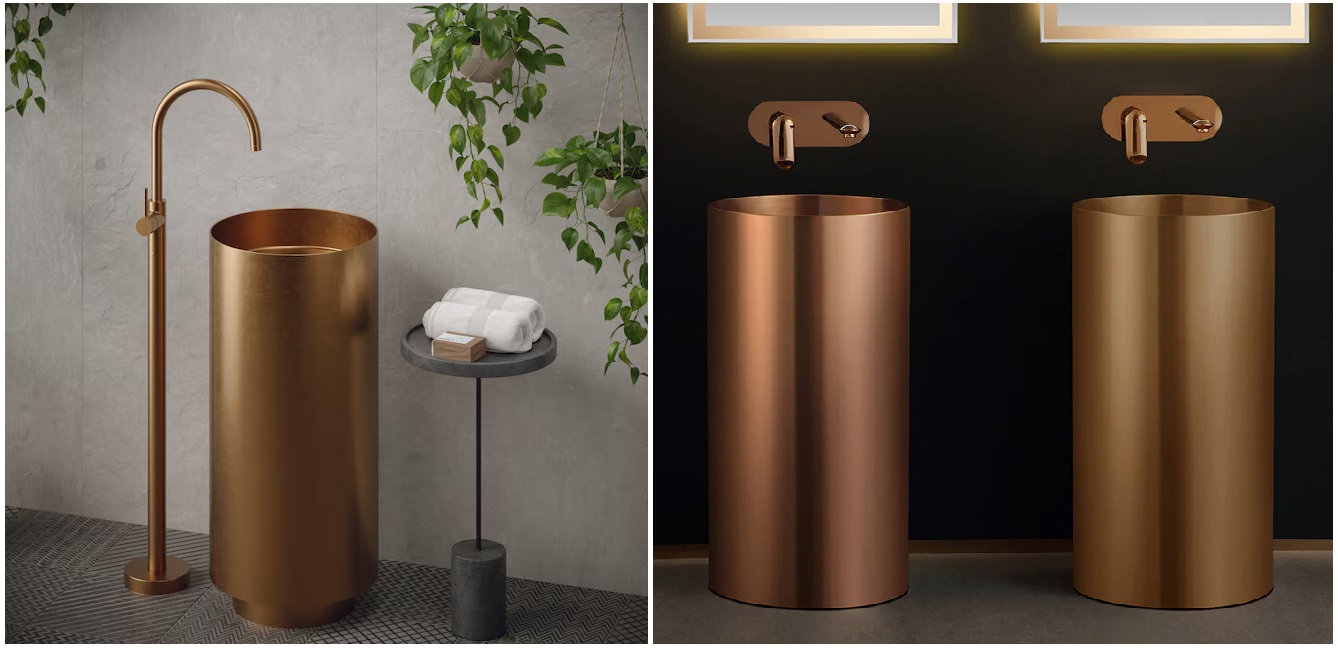
Architectural Considerations:
Architecturally, a copper pedestal sink serves as a functional focal point in traditional, rustic, or modern industrial bathrooms. Its warm tones and natural textures create a sense of luxury and uniqueness. Copper pairs seamlessly with materials like stone, wood, or glass, offering versatility in design. The pedestal style enhances vertical space and works well in smaller bathrooms where floor space is limited.
Copper pedestal sinks can also be customized to match architectural themes, such as Victorian, Mediterranean, or Farmhouse styles, making them a preferred choice for designers aiming to balance functionality with artistry.
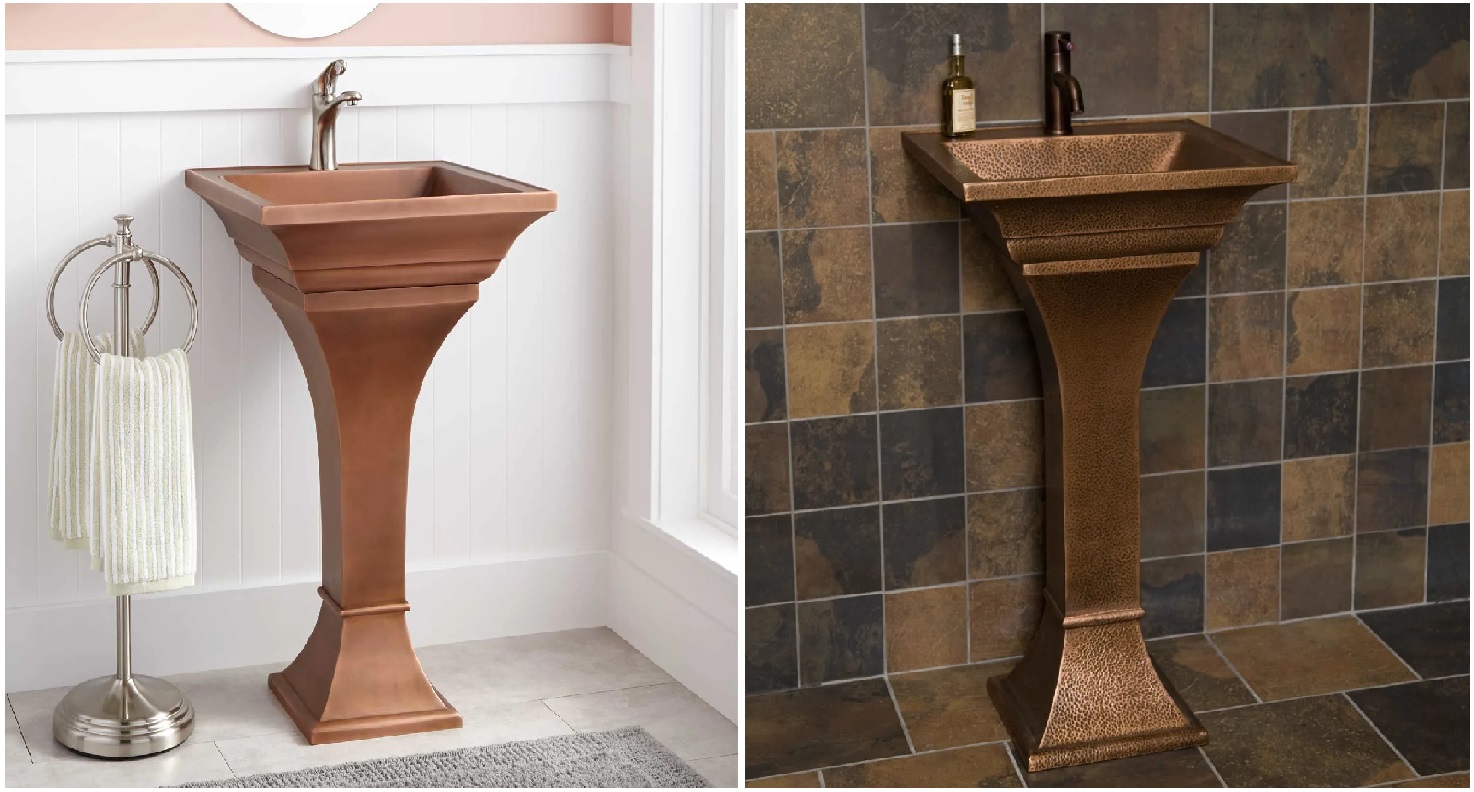
Why BathSelect Stands Out in the Market:
BathSelect differentiates itself in the market through its unmatched craftsmanship, design innovation, and commitment to quality. Unlike many competitors, BathSelect offers customizable copper pedestal sinks, allowing customers to choose from various finishes, textures, and sizes. Each sink is handcrafted by skilled artisans, ensuring a unique piece that stands out in any bathroom.
BathSelect incorporates advanced protective coatings that preserve the copperís natural beauty while minimizing maintenance needs. The brand also focuses on eco-friendly production methods, sourcing sustainable materials and using environmentally responsible processes.
Additionally, BathSelect provides comprehensive customer support and a warranty that reflects confidence in their products. Their designs cater to residential, commercial, and hospitality settings, offering a wide range of solutions to meet diverse architectural needs.
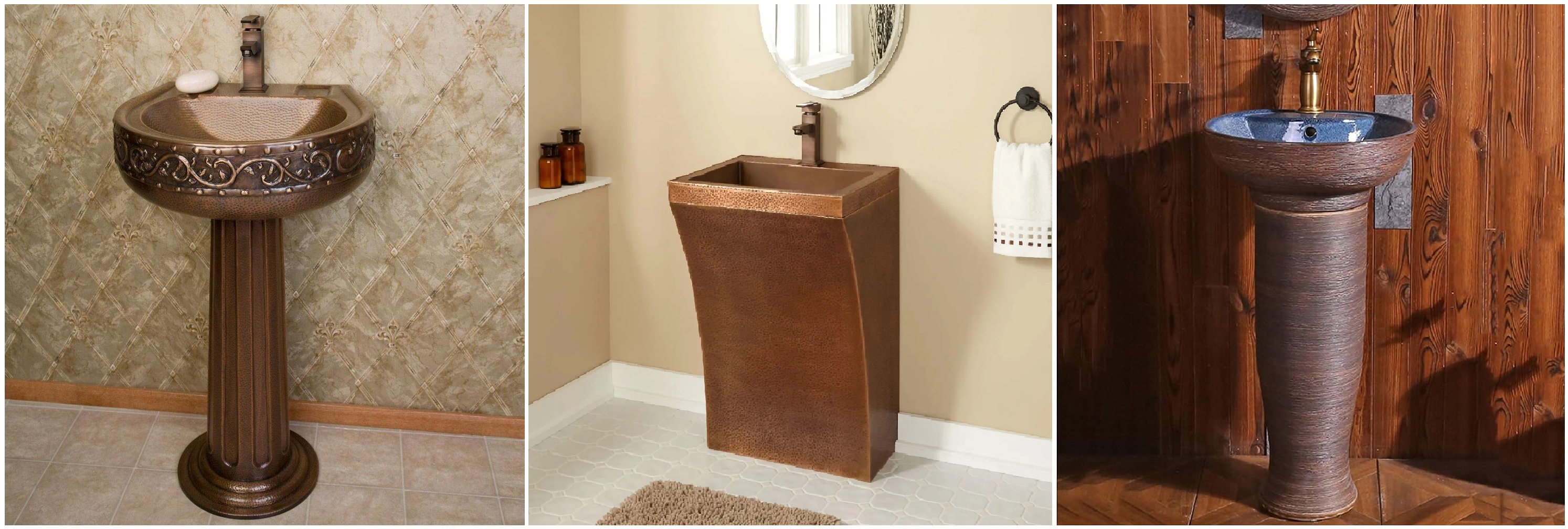
Conclusion:
A Copper Pedestal Sink from BathSelect is not just a functional fixture but a statement piece that combines durability, elegance, and timeless appeal. Its architectural versatility and superior craftsmanship set it apart, making it an investment that enhances both the aesthetic and practical value of any bathroom.
Dos and Doníts When Selecting a Copper Pedestal Sink:
Dos:
Choose High-Quality Copper
Opt for sinks made from pure, thick-gauge copper (16-18 gauge) to ensure durability and resistance to dents or warping.
Check for Protective Coatings
Ensure the sink has a non-toxic protective sealant to maintain its shine and prevent over-patina formation.
Match the Design with the Dťcor
Select a copper pedestal sink that complements your bathroomís architectural style, such as rustic, modern, or farmhouse.
Consider Sink Size and Space
Measure your bathroom to ensure the sink fits comfortably without overwhelming the space, especially in small or compact bathrooms.
Focus on Functional Features
Look for sinks with overflow options and properly designed drainage to avoid water pooling and stains.
Opt for a Hammered or Textured Finish
A hammered texture hides scratches and fingerprints better, maintaining a polished look over time.
Select a Reputable Brand
Choose brands like BathSelect, known for quality craftsmanship and durable materials, to ensure longevity and style.
Plan for Proper Plumbing
Confirm that the pedestal design conceals plumbing neatly and is compatible with your bathroom setup.
Test Compatibility with Faucets
Ensure the sink is compatible with the faucets you prefer, including single-hole, widespread, or wall-mounted designs.
Maintain Regular Cleaning
Use mild soap and water to clean the copper sink, preventing harsh chemical damage to its surface.
Doníts:
Donít Buy Thin-Gauge Copper
Avoid sinks made from copper thinner than 18-gauge, as they are prone to dents and damage.
Donít Ignore Patina Development
Remember that copper develops a natural patina over time; donít expect it to maintain a shiny, new appearance unless sealed.
Donít Overlook Maintenance Needs
Avoid sinks if you cannot commit to regular care, especially for uncoated copper that requires more upkeep.
Donít Use Harsh Chemicals
Never clean the sink with abrasive cleaners, bleach, or ammonia-based products, as they can damage the copper.
Donít Skip Checking Drain Material
Ensure the drain and plumbing are made from copper-compatible materials, such as brass, to prevent corrosion.
Donít Mismatch the Finish
Avoid selecting a copper sink if its finish clashes with other bathroom fixtures, like faucets or hardware.
Donít Forget to Verify Weight Support
Confirm that your bathroom floor and installation area can support the sinkís weight, especially for solid copper pedestal sinks.
Donít Install Without Expert Help
Avoid DIY installation if you lack plumbing experience, as improper setup can lead to leaks or instability.
Donít Neglect Environmental Factors
Ensure your bathroom has proper ventilation to reduce moisture that could accelerate patina formation.
Donít Assume All Copper is Equal
Avoid cheap sinks made from low-quality recycled copper or copper alloys that compromise durability and aesthetic appeal.
By adhering to these dos and doníts, you can ensure your Copper Pedestal Sink not only enhances your bathroom's aesthetics but also provides long-lasting functionality.
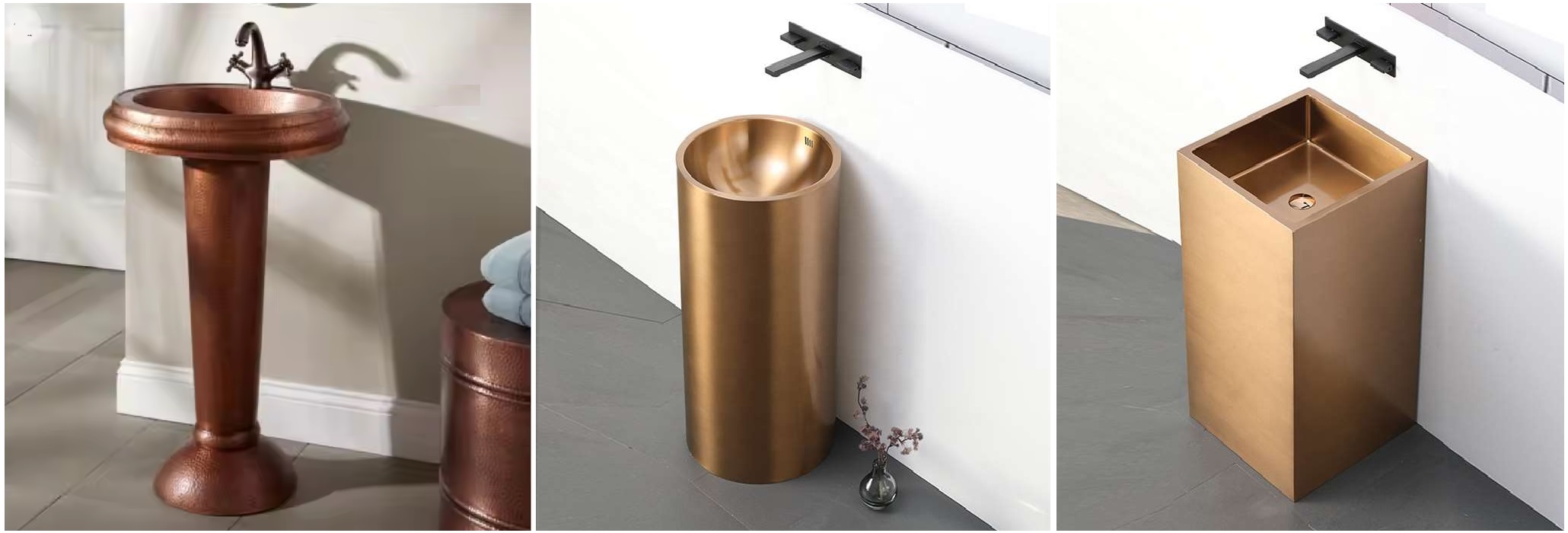
Test Compatibility with Faucets: A Key Step in Selecting Your Sink:
When selecting a sink, ensuring faucet compatibility is a critical step that should not be overlooked. The relationship between your sink and faucet affects not only the functionality of your bathroom or kitchen but also the aesthetic appeal of the overall design. Whether you are choosing a single-hole, widespread, or wall-mounted faucet, careful consideration of the sink's specifications is essential to avoid costly mistakes and ensure seamless integration.
Understanding Faucet Types:
Single-Hole Faucets:
These faucets require just one hole in the sink or countertop for installation. They are compact and ideal for minimalist designs or small spaces. If your sink comes with pre-drilled holes, ensure it has only one hole for compatibility with this faucet style. Alternatively, a sink with no pre-drilled holes allows flexibility to install a single-hole faucet.
Widespread Faucets
These faucets feature three separate components: the spout and two handles, typically spaced 8-16 inches apart. They require a sink with three pre-drilled holes at the appropriate spacing. This design is perfect for larger sinks or bathrooms aiming for a luxurious appearance. Verify the distance between the holes on your sink to ensure it matches the faucet specifications.
Wall-Mounted Faucets:
As the name suggests, these faucets are mounted on the wall above the sink rather than on the sink itself. They require careful alignment with the sinkís dimensions to ensure the spout extends far enough to reach the sink basin without causing splashing or inconvenience. Wall-mounted faucets pair well with vessel sinks or pedestal sinks where counter space is limited.
Key Considerations for Compatibility Testing:
Sink Hole Configuration:
Check the number and spacing of pre-drilled holes in the sink. If the faucet type you prefer does not align with the sinkís configuration, you may need to drill additional holes or cover unused ones with decorative plates.
Proportion and Scale:
Ensure the faucet's size complements the sink. A large faucet can overpower a small sink, while a small faucet may appear inadequate for a larger sink. The spout height and reach should also align with the sinkís depth and width to prevent water splashing.
Plumbing Connections:
Verify that the sinkís plumbing setup accommodates your faucet choice. Wall-mounted faucets, for instance, require plumbing lines to be installed in the wall, which may involve additional construction.
Aesthetic Cohesion:
The finish and style of the faucet should harmonize with the sink material and design. For example, a copper sink pairs beautifully with an oil-rubbed bronze or brushed nickel faucet, while a modern ceramic sink might look best with a polished chrome faucet.
Installation Complexity:
Some faucet designs, such as wall-mounted or widespread faucets, may require professional installation due to their complexity. Ensure the sink and faucet combination you choose aligns with your expertise or willingness to hire a professional.
Why Compatibility Matters:
Functionality: A mismatched faucet and sink can result in improper water flow, splashing, or leaks, reducing the functionality of the setup.
Aesthetic Balance: The wrong faucet can disrupt the visual harmony of your bathroom or kitchen, diminishing the appeal of the design.
Ease of Use: Compatibility ensures that the faucet and sink combination is comfortable to use, with adequate clearance and reach for daily tasks.
Cost Efficiency: Testing compatibility before purchase avoids the need for costly modifications, such as re-drilling holes or replacing incompatible components.
How to Test Compatibility:
Measure Dimensions:
Use a measuring tape to determine the distance between pre-drilled holes, the depth of the sink basin, and the clearance needed for the spout.
Consult Manufacturer Specifications:
Review the product details provided by the manufacturer for both the sink and faucet to confirm compatibility.
Seek Professional Advice:
If youíre unsure, consult a plumber or designer to ensure the selected faucet fits seamlessly with your chosen sink.
Mock Installations:
For wall-mounted faucets, consider a mock setup to verify the alignment between the spout and sink basin before committing to the installation.
Conclusion
Testing faucet compatibility with your sink is more than just a technical requirement; it is a vital aspect of achieving a functional, stylish, and cohesive bathroom or kitchen design. By carefully evaluating sink hole configurations, faucet type, proportions, and plumbing requirements, you can create a setup that enhances both usability and aesthetics. Taking the time to ensure compatibility can save time, money, and frustration while delivering a polished and efficient final product.
Premium Bathroom Shower Fixtures, Faucets & Sensor Technology
With over 30 years of expertise, BathSelect is a trusted source of premium/high-quality, timeless charm bathroom fixtures. Our diverse collection ranges from luxury shower systems to commercial touchless sensor faucets & automatic soap dispensers, elegant vanity faucets, multi-function shower heads, walk-in bathtubs, and more.
Whether designing your dream bathroom or remodeling to perfection, BathSelect has a range of showers and faucets available in various finishes, offering something for every project. Explore our collection and elevate your bathroom into a haven of style and functionality.
Redefining Hygienic Space
Bathtubs
Innovative
Perfect Styles ... Dream Bathroom
Smart Mirror
Configurations
Sculpting Elegance in Every Detail
Toilets
Exceptional
Perfect Reflection Ė Vanities Tailored to Your Lifestyle
Sinks
Reflection Designs
Elevate Your Bathroom Experience
Featured
Products


Standard Pedestal Sinks
Comprehensive Guide to Pedestal Sinks
Comprehensive Guide to Pedestal Sinks
Types of Pedestal Sinks
Standard Pedestal Sinks
The standard pedestal sink is the quintessential design in bathroom fixtures, combining functionality and aesthetics seamlessly. Featuring a standalone basin supported by a single pedestal, this type of sink is known for its timeless appeal. The structure conceals plumbing while offering a clean and uncluttered look, making it ideal for various bathroom layouts. Check all
Pedestal Sink
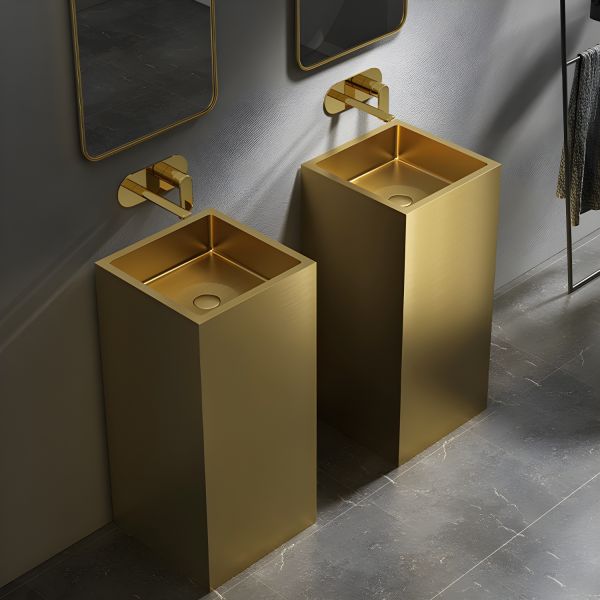
Standard pedestal sinks are particularly well-suited for small bathrooms and powder rooms. Their compact design ensures they take up minimal floor space while still providing a spacious basin for everyday use. They are also a favorite in classic and transitional design schemes, as their versatile aesthetics allow them to blend effortlessly with various styles.
One of the standout features of standard pedestal sinks is their variety of materials. Most commonly made of durable vitreous china or porcelain, these sinks are built to withstand daily wear and tear while maintaining a pristine finish. For those looking for a more luxurious feel, options in natural stone such as marble or granite are available, adding an element of sophistication to any bathroom.
The standard pedestal sink is available in numerous designs, from ornate, vintage-inspired models with intricate details to sleek, minimalist options for modern interiors. They often come in a wide range of sizes to accommodate different bathroom dimensions, with smaller models for compact spaces and larger ones for more spacious layouts.
Maintenance is another area where standard pedestal sinks excel. Their smooth surfaces and streamlined design make cleaning straightforward, with no hidden nooks or crannies to trap dirt. Furthermore, their durable finishes resist stains and scratches, ensuring they remain looking new for years to come.
In terms of installation, standard pedestal sinks require careful planning. The pedestal must align perfectly with the basin and the bathroomís plumbing system. Despite this, their installation is generally less complicated than wall-mounted or console sinks, making them a practical choice for homeowners and contractors alike.
Overall, the standard pedestal sink is a classic choice that combines practicality, elegance, and versatility. Whether youíre designing a traditional, modern, or transitional bathroom, this type of sink can serve as a focal point, enhancing the roomís overall aesthetic while providing reliable functionality.
Petite Pedestal Sinks
Compact versions of standard pedestal sinks, designed for tight spaces or minimalistic designs.
Semi-Pedestal Sinks
The pedestal is shorter, and the partially wall-mounted basin offers a floating effect that is perfect for contemporary spaces.
Corner Pedestal Sinks
It is available in various sizes and shapes and is designed to fit into corners to maximize space in small bathrooms.
Double Pedestal Sinks
Two sinks side by side, each supported by a pedestal, ideal for master bathrooms or shared spaces.
Pedestal Console Sinks
A mix of pedestal and console sink with an open area for storage beneath, combining traditional elegance with modern functionality.
Styles of Pedestal Sinks
Traditional
Features ornate details and rounded edges, complementing vintage or classic bathroom designs.
Contemporary
Sleek and minimalist designs with sharp lines and smooth surfaces, perfect for modern interiors.
Victorian/Colonial
Elaborate designs inspired by antique aesthetics, often including decorative carvings and oversized basins.
Transitional
Balances traditional and modern styles with neutral designs featuring subtle curves or edges.
Farmhouse
Rustic and durable designs emphasize utility, often paired with white porcelain or natural materials.
Art Deco
Bold geometric shapes and high-gloss finishes are perfect for retro or luxurious bathrooms.
Bathselect,offer the following: sink faucets, commercial sink faucets, , wall mount bathroom sink faucet, waterfall bathroom sink faucet,
|